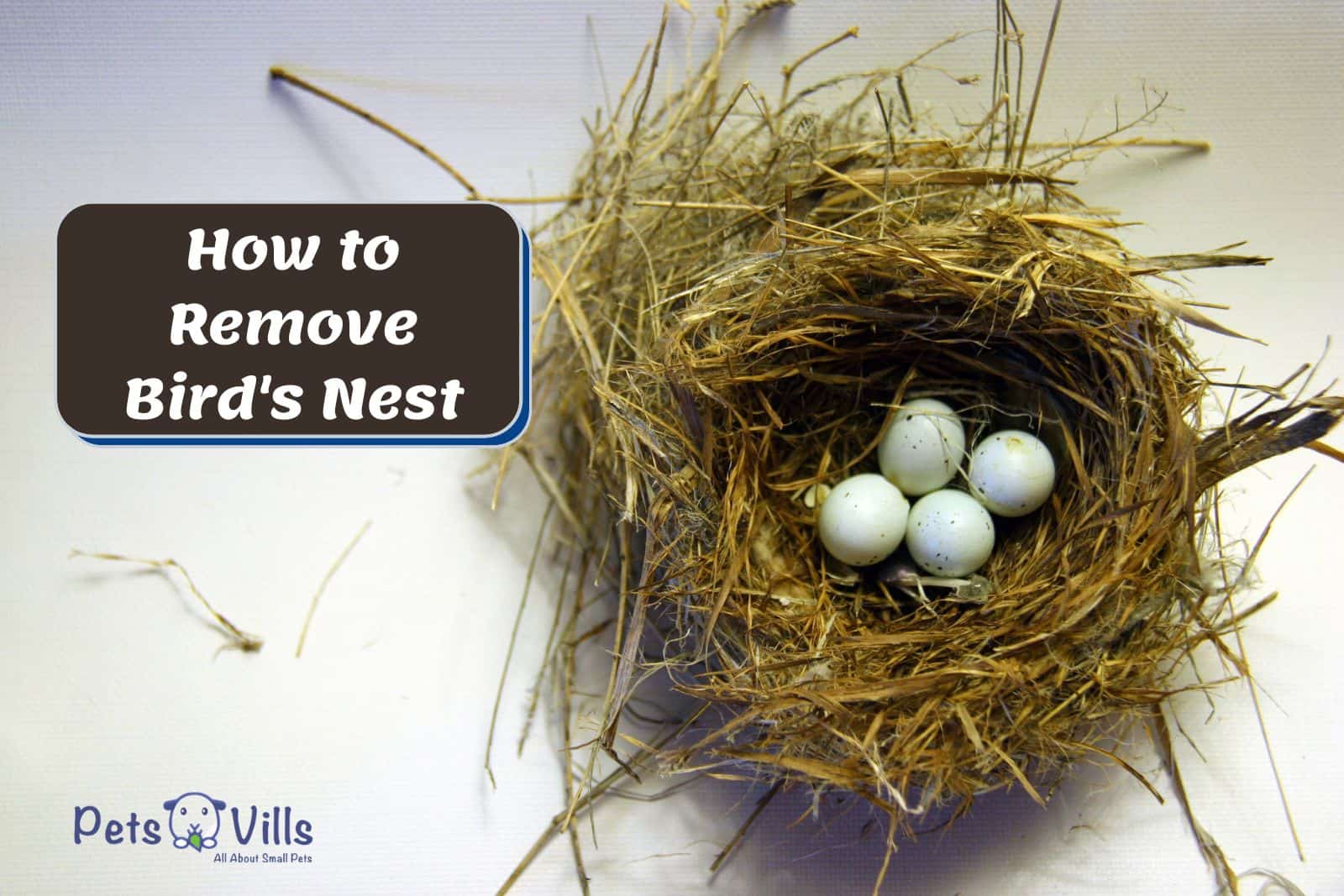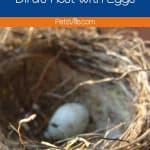As the days get warmer and the sun shines brighter, homeowners can expect to find an increasing number of birds nesting in their yards.
While many people may enjoy watching these beautiful creatures up close, others may want to get rid of the nest for fear that it will disturb their peace or damage their property.
If you fall into the latter category, don’t worry – removing a bird’s nest without harming the eggs is fairly easy! Here’s how:
6 Reasons Why You Might Need to Remove a Bird’s Nest
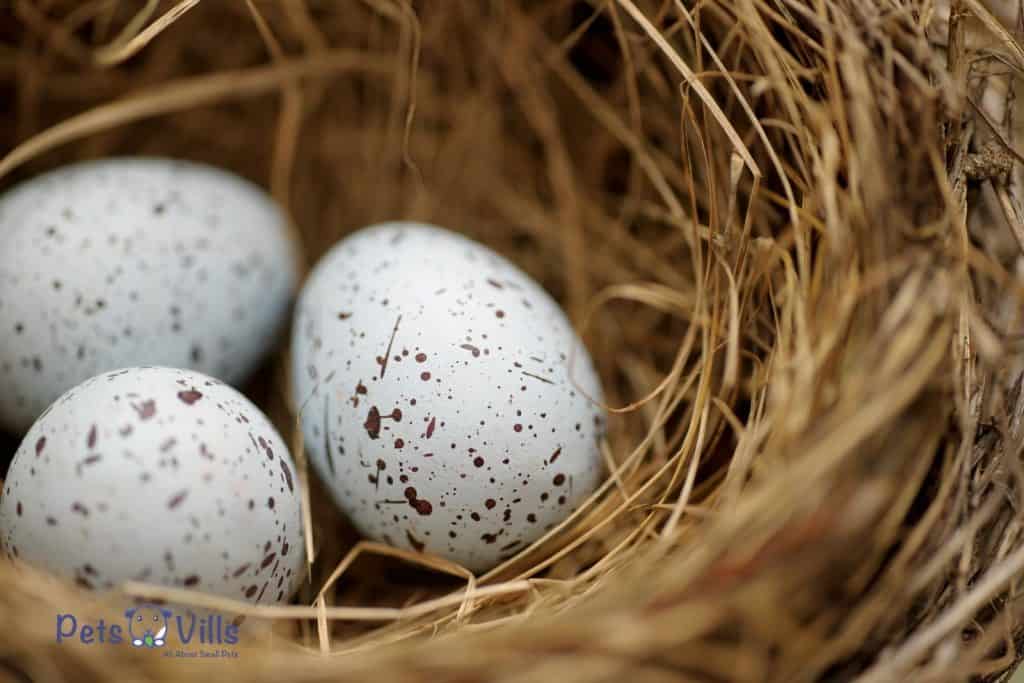
Most people enjoy having birds around, and many people go out of their way to attract birds to their yard by providing bird feeders and nesting boxes. However, there are also some instances where removing a bird’s nest might be necessary.
- The nest is located in a dangerous spot, such as on a power line or in a tree that is slated for removal.
- Nest is if it is causing property damage, such as by blocking a drainpipe or damaging gutters.
- The birds are creating too much noise or nuisance, such as roosting on your porch furniture.
- If you are doing construction or repairs on your home, the nest may need to be relocated to protect the birds.
- You may need to remove a nest that the birds have abandoned in some cases.
- The nest has dead birds. Dead birds usually have histoplasmosis [2], which can cause diseases even to human beings.
If you need to remove a nest, it’s essential to do so carefully and humanely, taking care not to harm the birds. With a bit of patience and effort, you can safely relocate the nest and provide the birds with a new home.
However, it is essential to note that it is against the law to remove an active nest without a permit. If you have questions about whether or not you can legally remove a bird’s nest, you should contact your local wildlife department.
READ MORE: How to Know if a Bird is Dead
The Laws Of Removing A Birds Nest
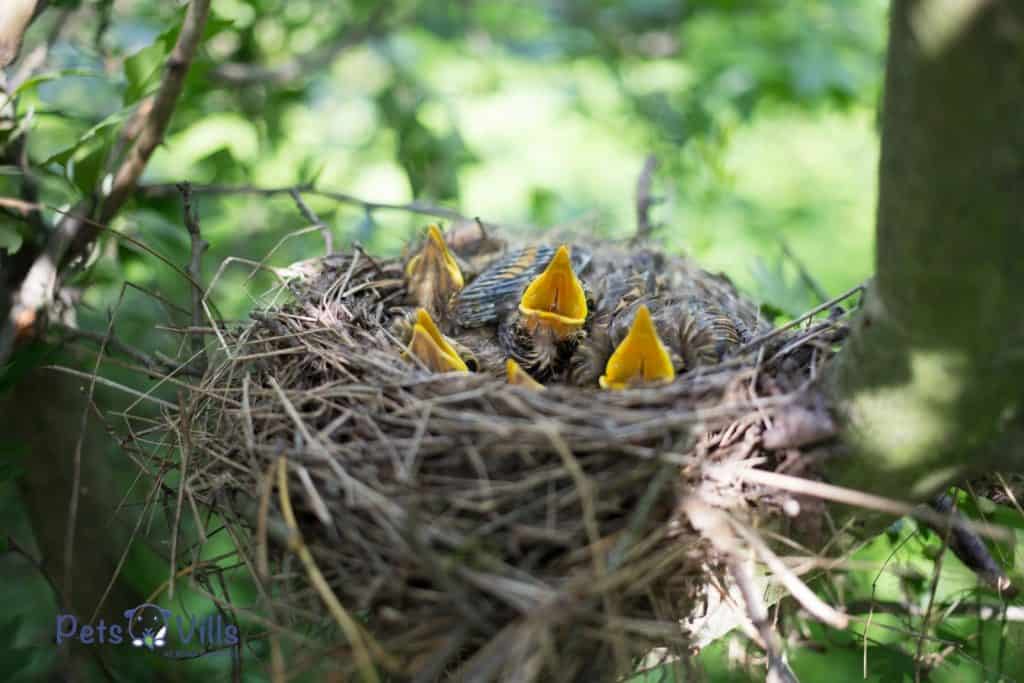
Bird nests and eggs are protected by the Federal Migratory Bird Treaty Act of 1918 [1]. This law protects more than 500 birds in the United States (including birds that nest in your backyard).
In the United States, it is illegal to destroy or remove bird nests until the end of the breeding season. You can destroy or remove it at the end of the breeding season (when there are no chicks or eggs in the nest).
However, keep in mind that if you remove or destroy a nest with chicks or eggs, you will be subject to fines under the 1916 Federal Migratory Birds Agreement Act.
So before removing or destroying a bird’s nest, see if it violates the 1916 Federal Migratory Bird Treaty Act.
Some birds in America do not need any approval from the Department of Wildlife Conservation to move or destroy their homes. These include:
- House Sparrow
- Common Grackle
- American Crow
- Red-winged Blackbird
- Brown-headed Cowbird
- European Starling
6 Easy Steps to Relocate A Birds Nest With Eggs
If you find a bird’s nest with eggs in your yard, there’s no need to panic! While it may seem daunting, relocating a bird’s nest is quite easy. Just follow these four simple steps:
Step 1: Identify the bird nest
First, you need to identify the location of the nest you want to remove. Birds usually nest on the roof or at the back of the house. Check if the nest is empty or has eggs.
Look for droppings on the ground or your porch or garage. If you cannot find any droppings, look for signs of birds such as feathers or nests on trees near your home.
Once you have located where the nest is, please choose a time when there are no birds around to remove it from its location and take it away from your home.
Use a ladder to verify if the nest is up too high. Experts recommend spraying the nest with an antibacterial spray to kill bacteria.
Step 2: Wear protective clothing
You must be very careful when removing bird nests because a bird’s nest contains various microorganisms, ticks, and parasites from which you can be infected with multiple diseases.
You need to wear masks, gloves, and protective clothing to protect yourself from these organisms.
You must wear a long-sleeved shirt, hand gloves, and long pants as protective clothing.
Step 3: Use a pole or broom handle
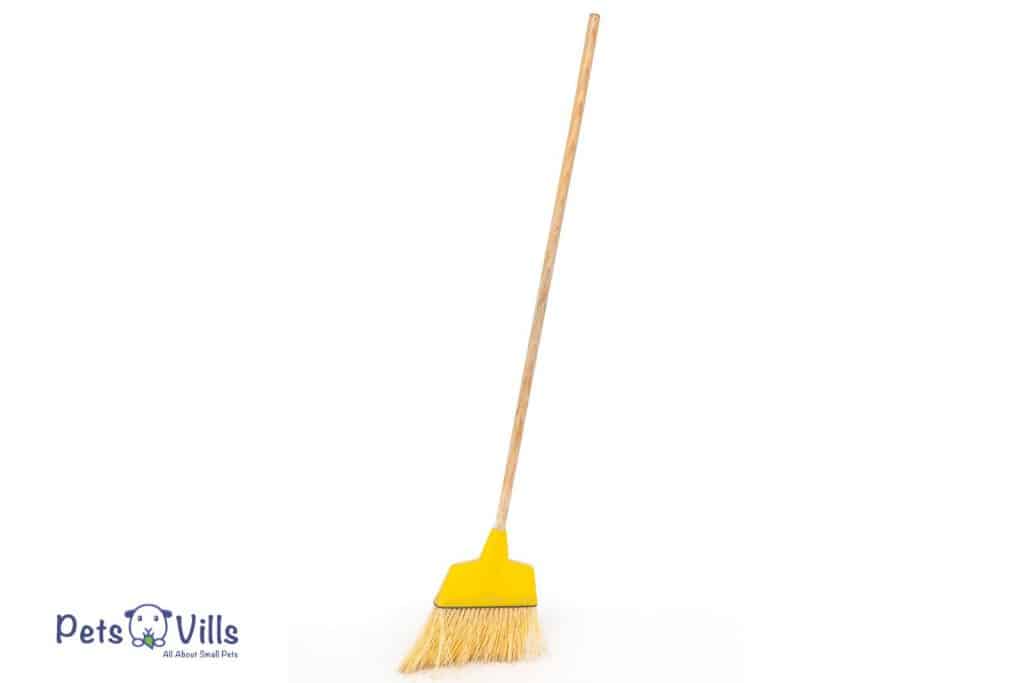
Use a broom handle or similar tool to gently push the nest out of its location. If the nest is too heavy to move with your hands, try using a pole or stick to push it out of the way gently.
Make sure that there are no baby birds in it before doing so! If there aren’t any babies, but there are leaves or other debris on top of the nest, try shaking them off first before trying different methods.
Step 4: Gently remove leaves and debris
Once you’ve removed most of the leaves covering your nest, you will have an easier time getting it out without damaging anything.
Using a pair of gardening gloves (to protect yourself from any sharp edges), pick up one side of the bottom edge with one hand and pull gently until all of your egg(s) come loose from their spot underneath it.
Step 5: Remove the nest
After wearing protective clothing, now is the perfect time to remove the bird’s nest. Remove the nest and move it to 200-300 meters away from your home.
This is because the dead bird’s nest contains various microorganisms, ticks, and parasites.
Step 6: Clean the space
After removing the birds’ nest, the place must be thoroughly cleaned. Because there may be bird stool dropping, which can spread diseases, use some water and bleaching powder mixed in a container to clean the area.
Use a 9:1 ratio for bleaching powder.
Now clean your used hand gloves, masks, and protective clothing by mixing disinfectant with hot water. Thoroughly wash your hand with lukewarm water and soap.
READ MORE: Do Birds Pick Up Their Babies?
Check out this video for more tips.
Nests You Should Not Remove
You should always contact your local authorities before removing a nest. Some nests should not be removed for one reason or the other.
Here are some nests that you should be cautious of:
- Nests of aggressive and dangerous birds, such as Owl and Raptor
- Nests built in early summer and maybe reused for additional broods
- Endangered birds that may not make a new nest after removing the present one
- Nests where a nesting season is running
- Nests that would be dangerous or unsafe to remove
Also, if you ever feel that you may be unable to remove the nest, be sure to talk to wildlife officials about the removal.
They will then arrange for the removal of the bird home in accordance with the Wildlife Conservation Act.
CHECK: How Long Does a Bird Egg Take to Hatch?
How to Stop Birds From Nesting in Unwanted Places
Birds will nest in any place that offers them protection and food. They may choose to build their nests in your trash cans or on the roof of your house.
If you don’t want birds in these areas, there are several ways to get rid of them.
#1 Create Barriers
Install bird netting over vulnerable spots like eaves and windowsills. Netting comes in rolls that measure 2 inches by 50 feet, which is enough for most small jobs; larger jobs require more material or custom-cut sizes.
#2 Use Pyrethrin Fogger
Use a fogger filled with pyrethrin (a natural insecticide) [3] or other repellent substance safe for use around pets and children.
Foggers release a dense mist of chemicals that repel pests without killing them outright; they’re typically used against flying insects such as mosquitoes, fleas, and flies but also work on birds because they don’t like the smell of the chemicals released into the air via fogger device
#3 Bird Deterrents
Hang shiny things like Mylar strips or aluminum foil to scare off birds. Hang them high enough that they don’t interfere with flight paths, and make sure not to hang them near power lines or other hazards.
Use fake owls or hawk decoys to scare off smaller birds.
Birds are often deterred by loud noises such as radios playing at full volume, or air horns blasted in short bursts every few minutes for several hours each day during nesting season.
#4 Prune Trees & Shrubs
Prune tree branches away from buildings and trim shrubbery so it doesn’t touch windows or siding.
FAQs
What happens if you disturb a bird’s nest?
Birds may abandon the nest if disturbed or harassed.
Is it OK to remove a bird’s nest?
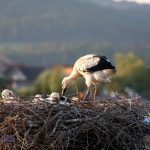
It is ok to remove the bird’s nest, but only after the bird has left the nest. Birds usually leave the nest at the end of the breeding season.
Do birds abandon their nest if you touch it?
No, they will not. Birds are not cued to human scent.
Are bird nests bad for your house?
Bird nests are not so bad for your home, but bird feeders or bird droppings ruin the beauty of the home.
Final Words
Now that you know how to remove a bird’s nest with eggs safely, you can rest assured knowing that the welfare of both the mother bird and her chicks is considered.
It’s important to remember that if you feel unsafe or uncomfortable at any time during this process, it is best to stop and call for professional help.
Bird nests can be beautiful additions to your garden, but it’s crucial to remember that they should never be disturbed unless there is an emergency.
Have you ever had to remove a bird’s nest? We want to hear about it! Share your story in the comments below.
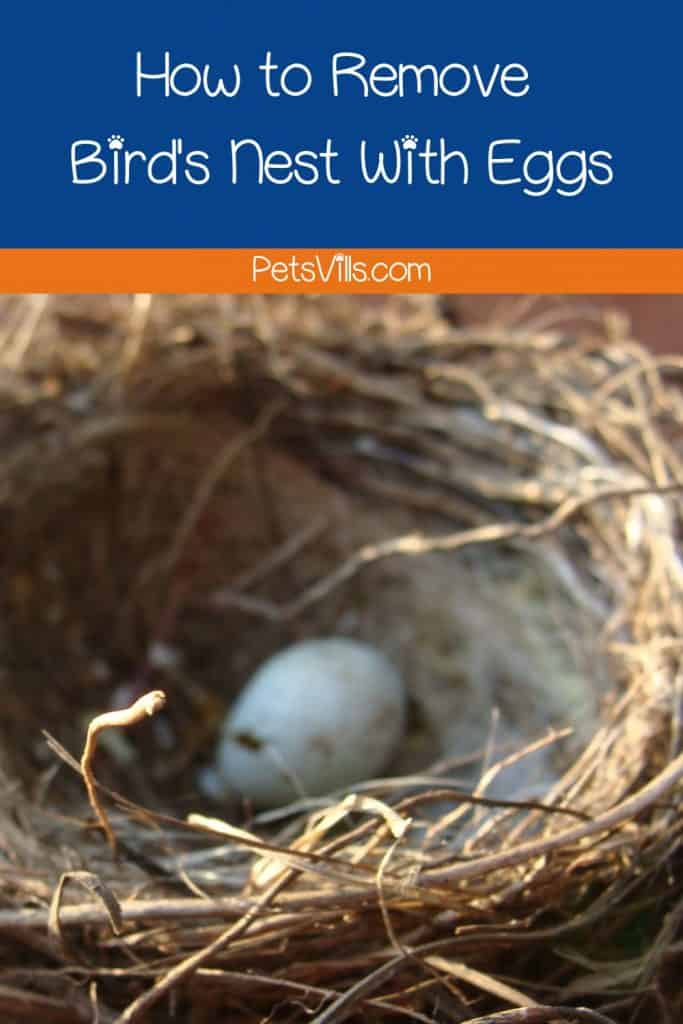
Resources
- 1. Migratory Bird Treaty Act of 1918 | U.S. Fish & Wildlife Service. www.fws.gov. https://www.fws.gov/law/migratory-bird-treaty-act-1918#:~:text=The%20Migratory%20Bird%20Treaty%20Act%20(MBTA)%20prohibits%20the%20take%20
- 2. Histoplasmosis | Types of Diseases | Fungal Diseases | CDC. www.cdc.gov. Published December 29, 2020
- 3. Pyrethrins. npic.orst.edu. Accessed June 3, 2022. http://npic.orst.edu/ingred/pyrethrins.html#:~:text=Pyrethrins%20are%20a%20mixture%20of
Barry Stingmore is a British content writer living in Fuerteventura, Spain. An animal lover at heart, he shares his home with a dog and four rescue cats and has a passion for writing about animals big and small.
Barry loves finding answers to your animal-related questions, the more research involved the better! You can rely on him to find the facts.
Find him on FACEBOOK, TWITTER AND Linkedin
Read his latest ARTICLES.
Find more about him HERE.

